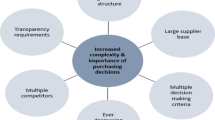Abstract
Supplier selection plays a key role in an organization because the cost of raw material constitutes the main cost of the final product. Selecting an appropriate supplier is now one of the most important decisions of the purchasing department. This decision generally depends on a number of different criteria. The objective of this paper is to propose a data envelopment analysis methodology that considers both undesirable outputs and imprecise data simultaneously. The proposed model is applied in supplier selection problem. A numerical example demonstrates the application of the proposed method.
Similar content being viewed by others
References
Akarte MM, Surendra NV, Ravi B, Rangaraj N (2001) Web based casting supplier evaluation using analytical hierarchy process. J Oper Res Soc 52(5):511–522
Banker RD, Charnes A, Cooper WW (1984) Some methods for estimating technical and scale inefficiencies in data envelopment analysis. Manage Sci 30(9):1078–1092
Charnes A, Cooper WW, Rhodes E (1978) Measuring the efficiency of decision making units. Eur J Oper Res 2(6):429–444
Färe R, Grosskopf S, Lovell CAK, Pasurka C (1989) Multilateral productivity comparisons when some outputs are undesirable: a nonparametric approach. Rev Econ Stat 71(1):90–98
Farzipoor Saen R (2005) Developing a nondiscretionary model of slacks-based measure in data envelopment analysis. Appl Math Comput 169(2):1440–1447
Farzipoor Saen R (2006) Technologies ranking in the presence of both cardinal and ordinal data. Appl Math Comput 176(2):476–487
Farzipoor Saen R (2007) Suppliers selection in the presence of both cardinal and ordinal data. Eur J Oper Res 183(2):741–747
Farzipoor Saen R (2008) Supplier selection by the new AR-IDEA model. Int J Adv Manuf Technol 39(11–12):1061–1070
Farzipoor Saen R (2009) Supplier selection by the pair of nondiscretionary factors-imprecise data envelopment analysis models. J Oper Res Soc 60(11):1575–1582
Farzipoor Saen R (2009) A decision model for ranking suppliers in the presence of cardinal and ordinal data, weight restrictions, and nondiscretionary factors. Ann Oper Res 172(1):177–192
Farzipoor Saen R (2009) A mathematical model for selecting third-party reverse logistics providers. Int J Procurement Manag 2(2):180–190
Farzipoor Saen R (2009) A mathematical programming approach for strategy ranking. Asia Pacific Manag Rev 14(2):109–120
Farzipoor Saen R (2010) A decision model for selecting appropriate suppliers. Int J Adv Oper Manag (in press)
Guneri AF, Yucel A, Ayyildiz G (2009) An integrated fuzzy-LP approach for a supplier selection problem in supply chain management. Expert Syst Appl 36(5):9223–9228
Hadi VA, Kazemi Matin R, Tavassoli Kajani M (2005) Undesirable factors in efficiency measurement. Appl Math Comput 163(2):547–552
Hsu CW, Hu AH (2009) Applying hazardous substance management to supplier selection using analytic network process. J Clean Prod 17(2):255–264
Jahanshahloo GR, Hadi Vencheh A, Foroughi AA, Kazemi Matin R (2004) Inputs/outputs estimation in DEA when some factors are undesirable. Appl Math Comput 156(1):19–32
Jahanshahloo GR, Hosseinzadeh Lotfi F, Shoja N, Tohidi G, Razavyan S (2005) Undesirable inputs and outputs in DEA models. Appl Math Comput 169(2):917–925
Kokangul A, Susuz Z (2009) Integrated analytical hierarch process and mathematical programming to supplier selection problem with quantity discount. Appl Math Model 33(3):1417–1429
Korhonen PJ, Luptacik M (2004) Eco-efficiency analysis of power plants: an extension of data envelopment analysis. Eur J Oper Res 154(2):437–446
Lee AHI, Kang HY, Hsu CF, Hung HC (2009) A green supplier selection model for high-tech industry. Expert Syst Appl 36(4):7917–7929
Liang L, Li Y, Li S (2009) Increasing the discriminatory power of DEA in the presence of the undesirable outputs and large dimensionality of data sets with PCA. Expert Syst Appl 36(3):5895–5899
Lin RH (2009) An integrated FANP–MOLP for supplier evaluation and order allocation. Appl Math Model 33(6):2730–2736
Lu WM, Lo SF (2007) A closer look at the economic–environmental disparities for regional development in China. Eur J Oper Res 183(2):882–894
Scheel H (2001) Undesirable outputs in efficiency valuations. Eur J Oper Res 132(2):400–410
Seiford LM, Zhu J (2002) Modeling undesirable factors in efficiency evaluation. Eur J Oper Res 142(1):16–20
Wang YM, Greatbanks R, Yang JB (2005) Interval efficiency assessment using data envelopment analysis. Fuzzy Sets Syst 153(3):347–370
Wu D (2009) Supplier selection: a hybrid model using DEA, decision tree and neural network. Expert Syst Appl 36(5):9105–9112
Wu D (2009) Supplier selection in a fuzzy group setting: a method using grey related analysis and Dempster–Shafer theory. Expert Syst Appl 36(5):8892–8899
Wu DD, Zhang Y, Wu D, Olson DL (2010) Fuzzy multi-objective programming for supplier selection and risk modeling: a possibility approach. Eur J Oper Res 200(3):774–787
Zhang B, Bi J, Fan Z, Yuan Z, Ge J (2008) Eco-efficiency analysis of industrial system in China: a data envelopment analysis approach. Ecol Econ 68(1-2):306–316
Author information
Authors and Affiliations
Corresponding author
Rights and permissions
About this article
Cite this article
Farzipoor Saen, R. Developing a new data envelopment analysis methodology for supplier selection in the presence of both undesirable outputs and imprecise data. Int J Adv Manuf Technol 51, 1243–1250 (2010). https://doi.org/10.1007/s00170-010-2694-3
Received:
Accepted:
Published:
Issue Date:
DOI: https://doi.org/10.1007/s00170-010-2694-3




